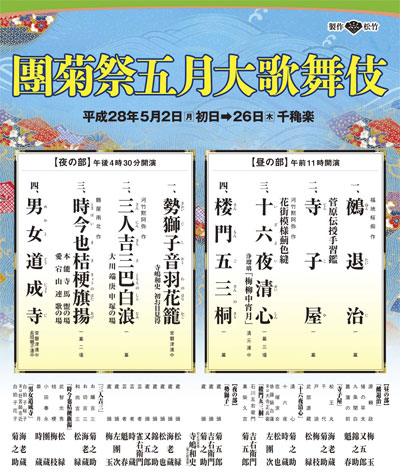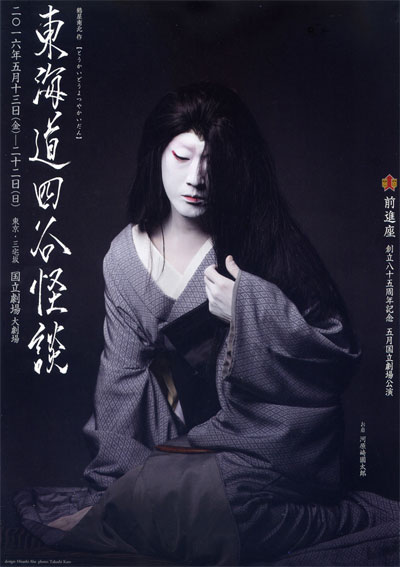| Casting |
Living National Treasure Onoe Kikugor˘, Living National Treasure Nakamura Kichiemon, Nakamura Tokiz˘, Nakamura Jakuemon, Nakamura Baigyoku, Nakamura Kaishun, Onoe Kikunosuke, Ichikawa Ebiz˘, Nakamura Kinnosuke, Onoe Sh˘roku, Ichikawa Sadanji, Ichikawa Danz˘,
Nakamura Matagor˘, Nakamura Baishi, Onoe Matsuya,
Kataoka Ichiz˘, Kawarasaki Gonjűr˘, Ichimura Kakitsu, Ichikawa Unosuke, Band˘ Shűch˘, Ichikawa Emiya, Band˘ Minosuke, Ichikawa Omez˘, Ichikawa Kudanji, Nakamura Matsue, Nakamura Matsue, Ichimura Kitsutar˘, Nakamura Kamenoj˘, Nakamura Mantar˘, Nakamura Tanenosuke, Ichimura Takematsu, ďtani Hiromatsu, Onoe Ukon, Terashima Kazufumi
|
| Comments |
The great yearly Dankiku festival
for the Naritaya and Otowaya guilds, which commemorates 2 great stars of
the Meiji era: Dan = Ichikawa Danjűr˘ IX
and Kiku = Onoe Kikugor˘ V.
Onoe Kikunosuke's son Terashima Kazufumi, who is also the grandson of two Living National Treasures, Onoe Kikugor˘ and Nakamura Kichiemon, makes his first stage appearance (omemie).
Nue Taiji: in the middle of 12th century as the Emperor has been tormented by a specter every night,
he orders Minamoto no Yorimasa (Nakamura Baigyoku) to annihilate the monster. Yorimasa strings the bow to ward off evil
spirits and shoots the Nue, a monster which has a monkey's head, raccoon dog's body, a tail of a snake
and a feet of a tiger. Kuj˘ Kanpaku (Nakamura Kinnosuke) praises his valor and allows him to marry a beautiful court
lady Sh˘bu-no-Mae (Nakamura Kaishun) whom he loves. He performs an auspicious dance and leaves with Sh˘bu-no-Mae
and his retainer Hayata (Nakamura Matagor˘).
Terakoya: Genz˘ and his wife Tonami run a small school and are
protecting Kan Sh˘j˘'s son and heir, saying that he is their son. However,
word has gotten out Kan Sh˘j˘'s son is there and Genz˘ has been ordered to
behead him. Moreover, Matsu˘maru is to come to inspect the head. Their only
alternative is to kill one of the other students as a substitute, but all of
the students are farmer's children who could never pass for the son of a court
aristocrat. However, a new boy arrives that day and Genz˘ makes the terrible
decision to kill him in the place of his lord. As it turns out, Matsu˘maru has
sent his own son to be sacrificed, because of his family's long loyalty to
Kan Sh˘j˘. But he must face the most terrible situation for a father,
inspecting the head of his own son and lying when he says that it is the
genuine head of the son of Kan Sh˘j˘. Finally Matsu˘maru reveals his true
feelings to Genz˘ and he and his wife Chiyo mourn their dead son.
Starring Ichikawa Ebiz˘ as Matsu˘maru, Onoe Sh˘roku as Genz˘, Onoe Kikunosuke as Chiyo and Nakamura Baishi as Tonami.
Featuring also Kataoka Ichiz˘ as Shund˘ Genba.
Izayoi Seishin: love suicides are common in Kabuki, but usually as the conclusion
of a play, a tragic end to a love that cannot be. The playwright Kawatake Mokuami gave this play
an ironic turn by putting the love suicide at the very beginning of the play.
The priest Seishin (Onoe Kikunosuke) and the courtesan Izayoi (Nakamura Tokiz˘) are ostracized for having an affair.
Seishin decides to forget her and concentrate on his religious training. Before he can leave,
though, Izayoi convinces him to die with her. They throw themselves into a river,
but both survive. Unaware that Izayoi is still alive and given the chance to start again,
Seishin gives up his religious vows and turns to a life of crime.
With Ichikawa Sadanji as the poet Hakuren, in reality the thief ďdera Sh˘bŕ.
Sanmon: though short, this play is one of the most visually spectacular
in Kabuki. The famous villain Ishikawa Goemon (Living National Treasure Nakamura Kichiemon) enjoys a sea of cherry blossoms
while sitting on top the large gate of Nanzenji Temple. His enjoyment of the scene
is cut short, though, by the appearance below of his arch-nemesis, the general
Mashiba Hisayoshi (Living National Treasure Onoe Kikugor˘).
Kioi Jishi: it is the day of Sann˘ Festival,
the festival for Sann˘ Gongen. The festival becomes lively as members of a firefighting gang dance to
kiyari song at the station where the sacred
sake is dedicated to god. Two heads of the firefighting
gang show in dance how Soga brothers avenged their father but it turns into a comic dance in time.
After a fascinating dance by geishas, shishimai (lion dance)
shows a mad dance. The head of a firefighting gang who enacted the shishimai appears
and dances a comic dance with masks of Okame (plain-looking woman) and Hyottoko (clown) in his hands.
The festival continues to be crowded with people forever. This month, Onoe Kikunosuke's first son will be
appearing on stage for the first time. And this show is arranged for celebrating him.
Sannin Kichisa:
(Three Thieves Named Kichisa)
The playwright Kawatake Mokuami excelled at portrayals of thieves and this short scene,
with its music and poetic lines, is one of his most famous.
A beautiful young woman helps out a woman who is lost on the road.
But she is actually Oj˘ Kichisa, a male thief who is disguised as a woman.
He steals an immense sum of money that the woman is carrying and this leads to
an encounter on this riverbank of three thieves, all with the name Kichisa.
The two others Kichisa are Osh˘ Kichisa, a bonze turned thief, and Ob˘ Kichisa, an ex-samurai turned thief
Though they start out as rivals, they decide to become blood brothers
and form a gang. Featuring Onoe Kikunosuke as Oj˘ Kichisa, Onoe Sh˘roku as Osh˘ Kichisa and Ichikawa Ebiz˘ as Ob˘ Kichisa.
Badarai: based on the true historical story of Akechi Mitsuhide who betrayed his
lord Oda Nobunaga and ruled Japan for a few short days before being defeated by
Toyotomi Hideyoshi, this play focuses on Mitsuhide and his tortured relationship
with the arrogant and unreasonable lord Nobunaga. It is one of the few period
plays by Tsuruya Nanboku IV still performed today and brings
the same sharp psychological insight and eye for the attractiveness of evil characters that make
his ghost plays and plays about commoners so powerful. Featuring Onoe Sh˘roku, Nakamura Tokiz˘, Ichikawa Danz˘ and Nakamura Baishi
in the roles of Takechi Mitsuhide (because of strict censorship, the real names were not used), Mitsuhide's wife Satsuki,
Oda Harunaga and Kiky˘.
Meoto D˘j˘ji: "Musume D˘j˘ji" is based
on a legend about a woman transformed into a serpent out of jealousy and who
destroys a temple bell keeping her from the
object of her love. The original dance shows the spirit of the woman who appears at
D˘j˘ji temple as a dancer who wants to celebrate the dedication of a new bell
and does a series of dances showing the many faces of femininity. In this version
there are two dancers and one is revealed to be a man in disguise and, in the
highlight of the dance, transforms the romantic highpoint of the original piece
into a comic scene by using masks. Starring Onoe Kikunosuke as the female dancer and
Ichikawa Ebiz˘ as the male dancer.
Sources: Earphone Guide Website or Sh˘chiku Kabuki Official Website
|



